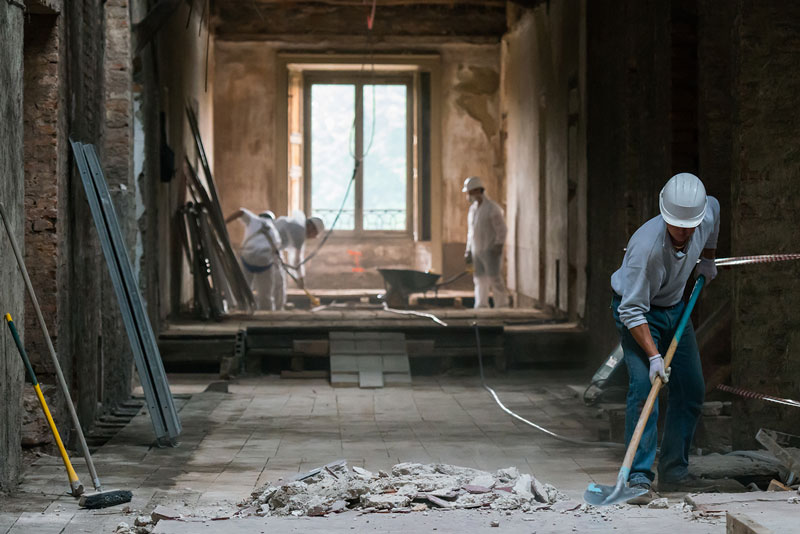Swinging a sledgehammer through drywall might seem like pure destruction, but interior demolition taps into something much deeper than breaking down walls. The act of tearing apart existing structures to create something new reflects a fundamental human desire for transformation and renewal. Understanding the psychological drivers behind interior demolition projects reveals why this process feels so satisfying and why it’s become an essential first step in countless renovation journeys.
When homeowners decide to tackle interior demolition, they’re not just removing outdated fixtures or creating open floor plans. They’re engaging in a symbolic act of letting go, clearing space for new possibilities, and taking control of their environment. This psychological dimension explains why demolition day often feels like the most exciting part of a renovation project, even though it’s technically just the beginning.
The emotional weight of interior demolition extends beyond personal satisfaction. It represents a decisive moment where plans become reality, where years of dreaming about change transform into concrete action. For many, wielding that first hammer blow against a wall marks the point of no return—a commitment to seeing their vision through to completion.
The Therapeutic Power of Controlled Destruction
Interior demolition offers a unique form of stress relief that few other activities can match. The physical act of breaking down walls, removing cabinets, and clearing out old fixtures provides an outlet for pent-up frustration and anxiety. Unlike other forms of exercise or stress relief, demolition has an immediate, visible impact that creates a sense of accomplishment.
This therapeutic aspect becomes particularly powerful when people are going through major life transitions. Divorce, job changes, empty nest syndrome, or other significant life events often coincide with interior demolition projects. The act of physically dismantling spaces that held memories of a previous life chapter helps process emotional change while creating room for new experiences.
The controlled nature of interior demolition also appeals to people who feel overwhelmed by chaos in other areas of their lives. When exterior circumstances feel unpredictable, taking charge of your physical environment through strategic demolition provides a sense of agency and control. You decide what stays, what goes, and how the transformation unfolds.
Why We Crave the Before-and-After Transformation
Social media has amplified our fascination with dramatic interior demolition transformations. Before-and-after photos of gutted rooms becoming stunning living spaces generate millions of views and likes. This popularity reflects our collective attraction to visible progress and dramatic change.
The appeal of interior demolition lies partly in its binary nature—something either exists or it doesn’t. Unlike many aspects of renovation that involve subtle improvements or gradual progress, demolition creates immediate, undeniable change. A wall that stood for decades disappears in hours, instantly altering the entire character of a space.
This dramatic transformation satisfies our desire for instant gratification while also providing hope for the future. When people see a completely gutted room, they can more easily visualize the potential for something beautiful to emerge. The blank slate created by thorough interior demolition becomes a canvas for imagination and possibility.
The Role of Interior Demolition in Reclaiming Space
Many interior demolition projects stem from a desire to reclaim space that has been underutilized or poorly configured. Families grow, needs change, and what once worked perfectly may become a source of daily frustration. Demolition allows homeowners to question fundamental assumptions about how their space should function.
The process of evaluating what to demolish forces people to think critically about their lifestyle and priorities. Do you need a formal dining room if you always eat in the kitchen? Would removing that wall create better flow for entertaining? These questions arise naturally during the planning phase of interior demolition and lead to more intentional design choices.
Reclaiming space through demolition also addresses the psychological weight of living with layouts that don’t match current needs. Every time you navigate around an awkward wall or struggle with a poorly designed room, you’re reminded of the disconnect between your space and your life. Interior demolition eliminates these daily frustrations and creates alignment between form and function.
The Economics of Emotional Investment
Interior demolition often represents the most cost-effective way to achieve dramatic change in a space. While the emotional satisfaction is significant, the financial logic is equally compelling. Instead of working around existing structures that don’t serve your needs, demolition allows you to start fresh and build exactly what you want.
The DIY potential of interior demolition also appeals to homeowners who want to contribute personally to their renovation project. Unlike electrical work or plumbing, which require professional expertise, much of interior demolition can be safely handled by motivated homeowners. This hands-on involvement creates a deeper emotional connection to the transformation process.
However, the economics of interior demolition extend beyond immediate cost savings. Removing walls, fixtures, and finishes that are outdated or in poor condition prevents future maintenance headaches and potential safety issues. The upfront investment in comprehensive demolition often pays dividends in reduced long-term maintenance costs and improved property value.
When Demolition Becomes a Family Experience
Interior demolition projects often become unexpected family bonding experiences. Children who are old enough to safely participate remember demolition day as an adventure, a chance to break rules and make noise in service of a greater goal. These shared experiences create lasting memories and teach valuable lessons about transformation and hard work.
The collaborative nature of interior demolition also strengthens relationships between partners and family members. Working together toward a common goal, seeing immediate results from your combined efforts, and overcoming challenges as a team builds confidence in your ability to tackle other projects together.
For families dealing with stress or transitions, interior demolition can provide a constructive outlet for energy and emotions. Instead of feeling helpless about changes happening in their lives, family members can channel their feelings into productive work that improves their living environment.
Planning Your Own Interior Demolition Journey
If you’re considering an interior demolition project, start by honestly assessing your motivations and expectations. Are you seeking stress relief, improved functionality, or aesthetic change? Understanding your underlying goals will help you plan a demolition strategy that delivers the psychological benefits you’re seeking.
Consider involving friends or family members in the process, but establish clear safety protocols and ensure everyone understands their role. The social aspect of interior demolition can enhance its therapeutic benefits, but safety should always be the top priority.
Document your progress with photos and videos. The before-and-after transformation you create will serve as a powerful reminder of what you can accomplish when you commit to change. These visual records also help you appreciate the magnitude of your achievement once the project is complete.
The Lasting Impact of Transformation
Interior Demolition projects offer more than just structural change—they cultivate planning skills, resilience, and confidence by challenging homeowners to envision transformation, navigate obstacles, and execute with purpose, lessons that carry over into many areas of life.
The psychological benefits of interior demolition continue long after the dust settles. Every time you walk through the transformed space, you’re reminded of your ability to create positive change. This sense of accomplishment and capability influences how you approach other challenges and opportunities.
Whether you’re planning a major renovation or simply feeling stuck in other areas of your life, consider the lessons that interior demolition offers. Sometimes the best way forward requires tearing down what no longer serves you and building something better in its place. The sledgehammer is just the beginning—the real transformation happens in your mind and heart.

















